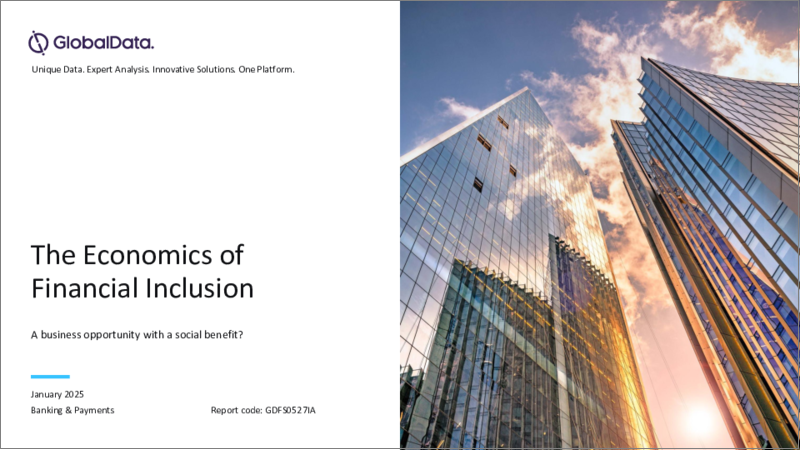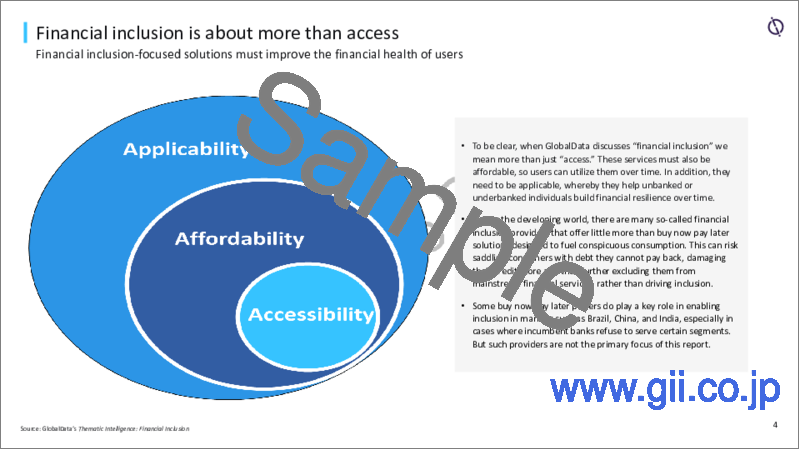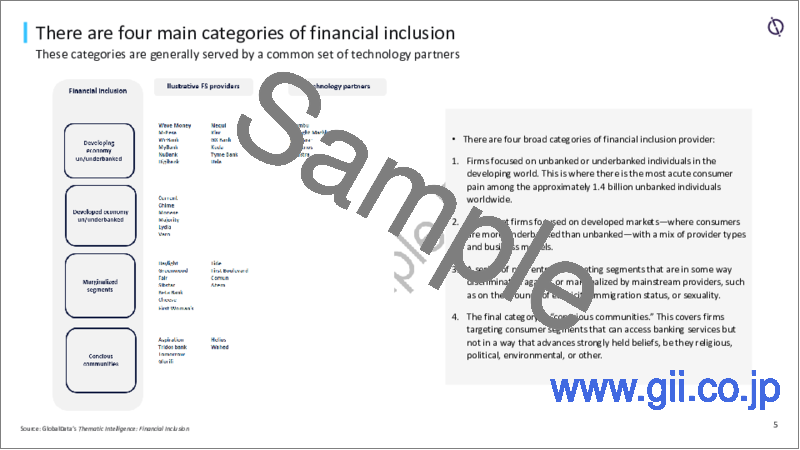|
|
市場調査レポート
商品コード
1646670
ファイナンシャル・インクルージョン(金融包摂)の経済学The Economics of Financial Inclusion |
||||||
カスタマイズ可能
適宜更新あり
|
|||||||
| ファイナンシャル・インクルージョン(金融包摂)の経済学 |
|
出版日: 2025年01月14日
発行: GlobalData
ページ情報: 英文 40 Pages
納期: 即納可能
|
- 全表示
- 概要
- 目次
ファイナンシャル・インクルージョン(金融包摂)という用語は、様々なタイプのプロバイダーやビジネスモデルをカバーしています。簡略化のため、私たちは、一般的に排除されている、あるいは十分なサービスを受けていない中核的なタイプの顧客を中心に分析を整理しています。これには、世界で14億人の銀行口座を持たない顧客、主流プロバイダーからある程度の差別を受けるグループ、金融サービスを利用することはできる一方で、彼らが最も関心を寄せている問題を前進させるような方法では利用できないコミュニティが含まれます。
中東・アフリカの消費者はプレミアム機能(回答者の85.4%)に最も積極的であり、この市場におけるインフラ・ライト・インクルージョンの市場環境が非常に良好であることを裏付けています。所得が最も低い個人は、意外にも、特に南北アメリカで過去6カ月以内に請求書や支払を滞納した可能性が最も高くなっています。男女別にファイナンシャル・ゴールを見てみると、当社の調査データでは男性と女性を分ける要素はほとんどなく、"予算を立てる"、"借金を返す"、"貯蓄と投資をする"といったゴールで1ポイント以上の差が出ることはほとんどありません。
当レポートでは、ファイナンシャル・インクルージョン(金融包摂)と、それが金融サービス・プロバイダーにもたらす機会について考察しています。ESGに対する考え方を背景に、金融包摂について考察しています。金融包摂に注力するプロバイダーを4つのタイプに分類し、一部のプロバイダーが立ち上げ後どのように推移してきたかを検証しています。また、様々な層の金融ニーズや目標を考慮しながら、金融包摂の機会を捉えようとする企業にとって、従うべき最善のアプローチを概説しています。
目次
第1章 ESG要素における金融包摂
第2章 市場原理との整合
第3章 ケーススタディと攻撃ベクトル
第4章 疎外された層
第5章 意識あるコミュニティ
第6章 重要ポイント
第7章 付録
This report explores financial inclusion and the opportunity it represents for financial services providers. It considers financial inclusion against the backdrop of attitudes toward ESG. It breaks down the four different types of providers focusing on financial inclusion, as well as examining how some of these providers have fared since launch. The report also outlines the best approaches to follow for companies aiming to seize the financial inclusion opportunity, while considering the financial needs and goals of various different demographics.
The term "financial inclusion" covers a wide variety of different provider types and business models. For simplicity, we organize our analysis around the core types of customers that are typically excluded or underserved. This includes the 1.4 billion unbanked or underbanked worldwide, as well as groups that experience some degree of discrimination from mainstream providers and communities that can access financial services-but not in ways that advance the issues they most care about.
Scope
- Consumers in the Middle East and Africa are most willing to pay for premium features (85.4% of respondents), underlining the highly favorable market conditions for infrastructure-lite inclusion plays in this market.
- GlobalData's 2024 Financial Services Consumer Survey found that individuals on the lowest incomes are unsurprisingly most likely to have fallen behind on bills and payments within the last six months, especially in the Americas.
- When we examine financial goals split by gender, our survey data suggests little to separate males and females-with rarely more than 1 percentage point difference across goals such as "budget better," "pay off debts," and "build savings and investments."
Reasons to Buy
- Learn about the key economically viable categories of financial inclusion.
- Understand the best attack vectors for attracting and retaining these segments.
- Identify areas where service or product provision can be common across segments, and where there is the most compelling case for market- or segment-level calibration.






